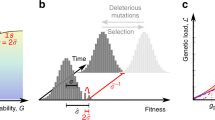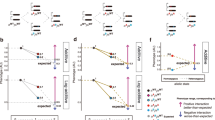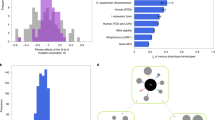Abstract
POPULATION geneticists have never agreed on the which overdominance of fitness—that is, the which the fitness of the heterozygote exceeds the fitness.of both homozygotes—is responsible for the maintenance of genetic variability in populations1. It has been proposed2–4 that heteromultimers formed by random association of enzyme subunits coded by two different alleles provide a molecular basis for overdominance. This hypothesis stems from the observation that heteromultimers often differ from homomultimers in a number of aspects5, sometimes restoring enzymatic activity when both homozygotes lacked such activity2. Clearly, the crucial step towards associating (or disassociating) observations of this type with overdominance of fitness must be taken if we were to test the hypothesis that heteromultimers per se are responsible for the high amounts of variation observed in populations. I argue here that the enormous amounts of electrophoretic data now available exclude this hypothesis.
This is a preview of subscription content, access via your institution
Access options
Subscribe to this journal
Receive 51 print issues and online access
$199.00 per year
only $3.90 per issue
Buy this article
- Purchase on Springer Link
- Instant access to full article PDF
Prices may be subject to local taxes which are calculated during checkout
Similar content being viewed by others
References
Lewontin, R. C., The Genetic Basis of Evolutionary Change (Columbia University, New York and London, 1974).
Fincham, J. R. S., Gene Complementation (Benjamin, Amsterdam, 1966).
Fincham, J. R. S., Heredity, 28, 387–391 (1972).
Schwartz, D., and Laughner, W. J., Science, 166, 626–627 (1969).
Singh, R. S., Hubby, J. L., and Lewontin, R. C., Proc. natn. Acad. Sci. U.S.A., 71, 1808–1810 (1974).
Brownlee, K. A., Statistical Theory and Methodology in Science and Engineering, second ed. (Wiley, New York, London and Sydney, 1965).
Harris, H., Hopkinson, D. A., and Robson, E. B., Ann. Hum. Genet., 37, 237–253 (1974).
Harris, H., and Hopkinson, D. A., Ann. Hum. Genet., 36, 9–20 (1972).
Hopkinson, D. A., Peters, J., and Harris, H., Ann. Hum. Genet., 37, 477–484 (1974).
Beutler, E., West, C., and Beutler, B., Ann. Hum. Genet., 38, 163–169 (1974).
Chen, S. H., Anderson, J., Giblett, E. R., and Lewis, M., Am. J. Hum. Genet., 26, 73–77 (1974).
Kompf, J., Bissbort, S., Gussmann, S., and Ritter, H., Humangenetik, 27, 141–143 (1975).
Beckman, G., and Christodoulou, C., Hum. Hered., 24, 294–299 (1974).
Teng, Y. S., Anderson, J. E., and Giblett, E. R., Am. J. Hum. Genet., 27, 492–497 (1975).
Turner, M. B., Turner, V. S., Beratis, N. G., and Hirschhorn, Am. J. Hum. Genet., 27, 651–661 (1975).
Povey, S., Corney, G., and Harris, H., Ann. Hum. Genet., 38, 407–415 (1975).
Slaughter, C. A., Hopkinson, D. A., and Harris, H., Ann. Hum. Genet., 39, 193–202 (1975).
Hopkinson, D. A., Coppock, J. S., Munlemann, M. F., and Edwards, Y. H., Ann. Hum. Genet., 38, 155–162 (1974).
Merritt, A. D., and Bixler, D., Proc. fourth Int. Congr. Hum. Genet., 120–121 (Excerpta Medica, Int. Congr. Ser. No. 233, Amsterdam, 1971).
Ward, J. C., Merritt, A. D., and Bixler, D., Am. J. Hum. Genet., 23, 403–409 (1971).
Selander, R. K., Smith, M. H., Yang, S. Y., Johnson, W. E., and Gentry, J. B., Studies in Genetics (Univ. Texas Publ. No. 7103, 1971).
Avise, J. C., and Selander, R. K., Evolution, 26, 1–19 (1972).
Ayala, F. J., Tracey, M. L., Barr, L. G., McDonald, J. F., and Perez-Salas, S., Genetics, 77, 343–384 (1974).
Gottlieb, L. D., Evolution, 29, 213–225 (1975).
Babbel, G. R., and Selander, R. K., Evolution, 28, 619–630 (1974).
Gillespie, J. H., and Langley, C. H., Genetics, 76, 837–848 (1974).
Johnson, G. B., Science, 184, 28–37 (1974).
Zouros, E., Nature, 254, 446–448 (1975).
Zouros, E., Krimbas, C. B., Tsakas, S., and Loukas, M., Genetics, 78, 1233–1244 (1974).
Zouros, E., Evolution, 27, 601–621 (1974).
Tsuno, K., Genetics, 80, 585–594 (1975).
Zouros, E., and Krimbas, C. B., Genet. Res., 14, 249–258 (1969).
Berger, E. M., Biol. Bull., 145, 83–90 (1973).
Smith, M. H., Selander, R. K., and Johnson, W. E., J. Mamm. Genet., 54, 1–13 (1973).
Bernstein, S. C., Thockmorton, L. H., and Hubby, J. L., Proc. natn. Acad. Sci. U.S.A., 70, 3928–3931 (1973).
Singh, R. S., Hubby, J. L., and Thockmorton, L. H., Genetics, 80, 637–650 (1975).
Prakash, S., Lewontin, R. C., and Hubby, J. L., Genetics, 61, 841–858 (1969).
Burns, M. J., and Johnson, F. M., Science, 156, 93–96 (1967).
Burns, M. J., and Johnson, F. M., Proc. natn. Acad. Sci. U.S.A., 68, 34–37 (1971).
Donald, L. J., and Robson, E. B., Ann. Hum. Genet., 37, 303–313 (1968).
Wallace, K., and Yarbrough, K. M., Proc. natn. Acad. Sci. U.S.A., 57, 645–649 (1967).
Kojima, K., and Yarbrough, K. M., Proc. natn. Acad. Sci. U.S.A., 57, 645–649 (1967).
Author information
Authors and Affiliations
Rights and permissions
About this article
Cite this article
ZOUROS, E. Hybrid molecules and the superiority of the heterozygote. Nature 262, 227–229 (1976). https://doi.org/10.1038/262227a0
Received:
Accepted:
Published:
Issue Date:
DOI: https://doi.org/10.1038/262227a0
This article is cited by
-
Allozyme divergence and phylogenetic relationships among species of tephritid flies
Heredity (1996)
-
Genetic variability and gene flow in geographical populations of Ceratitis capitata (Wied.) (medfly)
Heredity (1991)
-
Biochemical correlates of genetic variation in marine lower invertebrates
Biochemical Genetics (1989)
-
Isozymes as bioprobes for genetic analysis of nonhuman primates
Genetica (1987)
-
Enzyme heterozygosity associated with anatomical character variance and growth in the herring (Clupea harengus L.)
Heredity (1985)
Comments
By submitting a comment you agree to abide by our Terms and Community Guidelines. If you find something abusive or that does not comply with our terms or guidelines please flag it as inappropriate.



